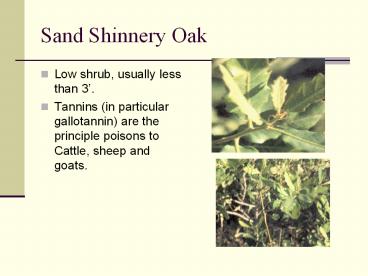Sand Shinnery Oak - PowerPoint PPT Presentation
Title:
Sand Shinnery Oak
Description:
Sand Shinnery Oak Low shrub, usually less than 3 . Tannins (in particular gallotannin) are the principle poisons to Cattle, sheep and goats. Golden Corydalis ... – PowerPoint PPT presentation
Number of Views:77
Avg rating:3.0/5.0
Title: Sand Shinnery Oak
1
Sand Shinnery Oak
- Low shrub, usually less than 3.
- Tannins (in particular gallotannin) are the
principle poisons to Cattle, sheep and goats.
2
Golden Corydalis (Corydalis aurea)
- Golden corydalis is a spreading, yellow-flowered
member of the poppy family. - This plant reportedly contains up to 10
alkaloids. Sheep relish this plant. Cattle and
horses are much more resistant.
3
Mountain Pink (Centaurium beyrichii)
- Two species are found in West Texas, both annual
or biennial plants. - Toxic principle is unknown. Suspected to be
poisonous to cattle, sheep and goats.
4
Mountain Pink
- Also called Rosita, has oblong to lanceolate
leaves less than ½ inch wide, and up to 2 long.
5
Sacahuista (Nolina texana)
- Sacahuista is a perennial member of the lily
family. - Toxic agent saponin contained in the flowering
buds, blooms and fruit. Sheep, goats and cattle
avidly eat these plant parts.
6
Tobosagrass Ergot (Claviceps cinerea)
- Toxic fungus that parasitizes the ovary of the
developing tobosagrass flower. Infection occurs
when the grass flower opens. - Toxic agent appears to be caused by a variety of
alkaloids and In some, tremorgens.
7
Kleingrass (Panicum coloratum)
- Tufted perennial bunch grass with stems 20 to 50
inches tall arising from firm, often knotty
bases. - If managed properly, kleingrass provides abundant
good-quality forage for livestock. However,
sheep and goats can develop severe
photosensitization and liver damage.
8
Johnsongrass (Sorghum halepense)
- Vigorous, coarse, perennial grass with scaly root
stalks that can reproduce by underground rhizomes
and seed. - Toxic agent caused by hydrocyanic acid (HCN)
poisoning. All domestic animals are susceptible
to HCN cattle are most susceptible.

